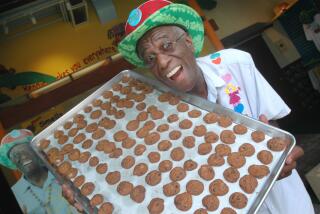Philip ‘Flippy’ Hoffman dies at 80; big-wave pioneer co-owned surfwear-related fabric company
Philip “Flippy” Hoffman, a pioneer of big-wave riding in Hawaii in the 1950s and the co-owner of Mission Viejo-based Hoffman California Fabrics, which supplies printed textiles to the surfwear, quilt and craft industries, has died. He was 80.
Hoffman, a Capistrano Beach resident, died Wednesday at Mission Hospital in Mission Viejo of complications related to pulmonary disease, said his son, Marty.
FOR THE RECORD:
Philip Hoffman: A photograph that accompanied the obituary of big-wave surfer and businessman Philip “Flippy” Hoffman in the Nov. 16 LATExtra section was credited to Jeff Devine. The photographer’s name is Jeff Divine. —
The son of a wool flannel salesman who founded Hoffman California Fabrics in Los Angeles in 1924, Hoffman joined the company in the late 1950s after working as a commercial abalone diver. He and his younger brother, Walter, took over the business in the early ‘70s.
Hoffman was chairman of the company, whose clients include brands such as Ocean Pacific, Quiksilver, Volcom, Stussy, Surfline Hawaii and Hinano Tahiti.
In the 1980s, one of the Hoffman tropical screen-print designs was used for the iconic aloha shirt worn by Tom Selleck in the TV series “Magnum, P.I.” The garment is now in the Smithsonian Institution.
During much of his career, Hoffman oversaw the company’s retail division, which served major retail stores such as Home Silk Shop and House of Fabrics as well as independent quilt and fabric stores. He also was involved in the research and development of textile manufacturing processes, design creation, artwork and merchandising.
But Hoffman wasn’t all business.
“When the surf was really big, he’d take off and go surfing,” Walter Hoffman, a fellow surfer, said of his brother.
As Flippy Hoffman told The Times in 1980: “When the surf is up, we’ll hit it in the morning — work — and then be back in the evening.”
Born in Glendale on Jan. 24, 1930, Hoffman grew up in Hollywood. His family spent summers in Laguna Beach, and as a teenager he learned to surf at San Onofre and Salt Creek.
Dubbed “Flippy” by his parents — “I don’t know why we called him that,” said his brother — Hoffman graduated from Hollywood High School in 1948.
He moved to Laguna and launched a 15-year career as a commercial abalone diver. He also served in the Coast Guard Reserve in the early ‘50s.
Inspired by 8-millimeter footage of Makaha’s big waves shot by his brother while stationed at Pearl Harbor, Hoffman made his first surfing trip to Hawaii in late 1952.
In early 1953, Hoffman and surfboard designer Bob Simmons became the first surfers to rent a house at Sunset Point on Oahu’s North Shore, according to Matt Warshaw’s “The Encyclopedia of Surfing” (2003).
“He was part of that first group of Californians that went over to Hawaii and helped to make big-wave surfing a full-time pursuit,” Warshaw told The Times on Monday. “They were looking to ride bigger waves than anyone before that, and they went out there and did it.”
Hoffman and a friend also are regarded as the first Californians to dive and surf along the coast of Mexico from the Sea of Cortez to Manzanillo in the early ‘50s, said Steve Pezman, publisher of The Surfer’s Journal.
“He and a buddy took a small craft on a diving trip, and they brought surfboards along,” Pezman said. “They surfed everything they encountered that looked good.”
For many years, Hoffman traveled every winter to surf in Hawaii.
With a 15-foot swell running on Jan. 19, 1975, according to Warshaw’s book, Hoffman “and three others became the first to ride Kaena Point, a break regarded at the time as the final big-wave frontier.”
To reach the break, they had to be dropped off by boat and then paddle into the waves, Pezman said.
Kaena Point is the extreme western tip of Oahu.
“It’s wild and not inhabited,” Pezman said. “When you’re driving around the point, you stop and look at the waves. They were so awe-inspiring, but no one would dare surf them, and you couldn’t paddle out to them from the beach.
“They just went out there and conquered this place.”
Four years later, according to Warshaw’s book, “Hoffman and surfer/board-maker Mickey Munoz built themselves 16-foot boards and became the first surfers to ride the North Shore’s outer reefs, taking off on relatively benign 18-foot waves about three-quarters of a mile from the beach.”
Marty Hoffman said his father also was an early user of jet skis to reach giant surf on the outer reefs.
“Amongst the inner circles of watermen, he was their hero,” Pezman said of Hoffman. “He was gruff, bright, straight-ahead and had no fear, and they all hugely respected him. He was adventurous, took risks and had no regard for his own safety. He just loved being in the ocean in any way he could.”
The Hoffman brothers’ love of surfing also paid an unexpected business dividend.
During a surf trip to Bali in the early 1980s, they saw hand-dyed and hand-printed batik fabrics. Their company began importing them and helped build a plant there to do the work. Walter Hoffman said batiks now make up a third of Hoffman California Fabrics’ production line.
In 2006, Philip and Walter Hoffman were inducted into the Surfing Walk of Fame in Huntington Beach.
In addition to his son and brother, Hoffman is survived by his life partner of 31 years, Suzy Aplanalp; his daughter, Dana Cederberg; five grandchildren; and three great-grandchildren.
A private funeral service will be held Tuesday; a memorial service is pending.
More to Read
Start your day right
Sign up for Essential California for the L.A. Times biggest news, features and recommendations in your inbox six days a week.
You may occasionally receive promotional content from the Los Angeles Times.






